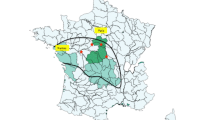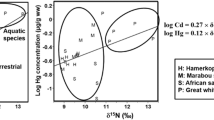Abstract
The eastern North American population of Barrow’s goldeneyes winters in the St. Lawrence Estuary and Gulf of St. Lawrence where the sediments and food web are known to be contaminated with inorganic and organic compounds. Therefore, there is a potential for contamination of this population, which is designated of Special Concern by the Committee on the Status of Endangered Wildlife in Canada. Specimens were collected during three consecutive winters (2005–2007) in three regions (Manicouagan, Charlevoix, and Chaleur Bay) and analysed for metals, trace elements, polychlorinated biphenyls (PCBs), organochlorine pesticides, and brominated flame retardants (BFRs). Liver mercury levels were greater in the St. Larence Estuary (4.4 mg/kg in Manicouagan, 3.8 mg/kg in Charlevoix) than in Chaleur (2.4 mg/kg), whereas selenium showed the opposite pattern (7.3 mg/kg in Manicouagan, 7.0 mg/kg in Charlevoix, and 36.9 mg/kg in Chaleur). Liver PCB levels were greater in specimens from Manicouagan (236 ng/g) than in those from the two other regions (72 ng/g in Charlevoix, 35 ng/g in Chaleur). DDT was greater in Chaleur (66 ng/g) versus 10 ng/g in Manicouagan and 16 ng/g in Charlevoix. BFRs were not compared among regions because of smaller sample sizes, but mean total concentration was low (4.02 ng/g). Overall, although significant differences were found across regions, levels of all contaminants measured are generally low and not of toxicological concern for this population.

Similar content being viewed by others
References
Aguilar A (1984) Relationship of DDE/DDT in marine mammals to the chronology of DDT input into the ecosystem. Can J Fish Aquat Sci 41:840–844
Blus LJ (2011) DDT, DDD, and DDE in birds. In: Beyer WN, Meador JP (eds) Environmental contaminants in biota: Interpreting tissue concentrations, 2nd edn. CRC Press, Boca Raton, pp 425–445
Bourget D, Savard JPL, Guillemette M (2007) Distribution, diet and dive behavior of Barrow’s and common goldeneyes during spring and autumn in the St. Lawrence Estuary. Waterbirds 30:230–240
Braune BM, Malone J (2006a) Mercury and selenium in livers of waterfowl harvested in Northern Canada. Arch Environ Contam Toxicol 50:284–289
Braune BM, Malone J (2006b) Organochlorines and mercury in waterfowl harvested in Canada. Environ Monit Assess 114:331–359
Committee on the Status of Endangered Wildlife in Canada (2010) Canadian wildlife species at risk. http://www.cosewic.gc.ca/eng/sct0/rpt/rpt_csar_e.cfm. Accessed: 2011
Cossa D, Gobeil C (2000) Mercury speciation in the Lower St. Lawrence Estuary. Can J Fish Aquat Sci 57:138–147
Custer CM, Custer TW, Anteau MJ, Afton AD, Wooten DE (2003) Trace elements in lesser scaup (Aythya affinis) from the Mississippi Flyway. Ecotoxicology 12:47–54
DeVink JMA, Clark RG, Slattery SM, Wayland M (2008) Is selenium affecting body condition and reproduction in boreal breeding scaup, scoters, and ring-necked ducks? Environ Pollut 152:116–122
Elliott JE, Martin PA (1998) Chlorinated hydrocarbon contaminants in grebes and seaducks wintering on the coast of British Columbia, Canada—1988-1993. Environ Monit Assess 53:337–362
Elliott JE, Harris ML, Wilson LK, Smith BD, Batchelor SP, Maguire J (2007) Butyltins, trace metals and morphological variables in surf scoter (Melanitta perspicillata) wintering on the south coast of British Columbia, Canada. Environ Pollut 149:114–124
EPA Method 7473 (1998) Mercury in solids and solutions by thermal decomposition, amalgamation, and atomic absorption spectrometry (Rev). http://www.leco.com/products/organic/ama_254/pdf/7473.pdf
Franson JC, Koehl PS, Derksen DV, Rothe TC, Bunck CM, Moore JF (1995) Heavy metals in seaducks and mussels from Misty Fjords National Monument in southeast Alaska. Environ Monit Assess 36:149–167
Fraser M, Surette C, Vaillancourt C (2011) Spatial and temporal distribution of heavy metal concentrations in mussels (Mytilus edulis) from the Baie des Chaleurs, New Brunswick, Canada. Mar Pollut Bull 62:1345–1351
Furness RW (1996) Cadmium in birds. In: Beyer WN, Heinz GH, Redmon-Norwood AW (eds) Environmental contaminants in wildlife. Lewis, New York, pp 447–458
Hebert CE, Keenleyside KA (1995) To normalize or not to normalize? Fat is the question. Environ Toxicol Chem 14:801–808
Heinz GH (1996) Selenium in birds. In: Beyer WN, Heinz GH, Redmon-Norwood AW (eds) Environmental contaminants in wildlife. Lewis, New York, pp 447–458
Heinz GH, Pendleton GW, Krynitsky AJ, Gold LG (1990) Selenium accumulation and elimination in mallards. Arch Environ Contam Toxicol 19:374–379
Henny CJ, Rudis DD, Roffe TJ, Robinson-Wilson E (1995) Contaminants and sea ducks in Alaska and the circumpolar region. Environ Health Perspect 103(Suppl 4):41–49
Hoffman DJ, Rice CP, Kubiak TJ (1996) PCBs and dioxins in birds. In: Beyer WN, Heinz GH, Redmon-Norwood AW (eds) Environmental contaminants in wildlife. Lewis, New York, pp 165–207
Kerswill CJ (1967) Studies on effects of forest sprayings with insecticides, 1952–63, on fish and aquatic invertebrates in New Brunswick streams: introduction and summary. J Fish Res Board Can 24:701–708
Lacroix A, Fournier M, Lebeuf M, Nagler JJ, Cyr DG (2001) Phagocytic response of macrophages from the pronephros of American plaice (Hippoglossoides platessoides) exposed to contaminated sediments from Baie des Anglais, Quebec. Chemosphere 45:599–607
Lavoie RA, Champoux L, Rail JF, Lean DRS (2010) Organochlorines, brominated flame retardants and mercury levels in six seabird species from the Gulf of St. Lawrence (Canada): relationships with feeding ecology, migration and molt. Environ Pollut 156:2189–2199
Law RJ, Allchin CR, Bennett ME, Morris S, Rogan E (2002) Polybrominated diphenyl ethers in two species of marine top predators from England and Wales. Chemosphere 46:673–681
Lee K, Nagler JJ, Fournier M, Lebeuf M, Cyr DG (1999) Toxicological characterization of sediments from Baie des Anglais on the St. Lawrence estuary. Chemosphere 39:1019–1035
Miller EK, Vanarsdale A, Keeler GJ, Chalmers A, Poissant L, Kamman NC et al (2005) Estimation and mapping of wet and dry mercury deposition across northeastern North America. Ecotoxicology 14:53–70
Neugebauer EA, Sans Cartier GL, Wakeford BJ (2000) Methods for the determination of metals in wildlife tissues using various atomic absorption spectrophotometry techniques. Technical Report Series no. 337E. Canadian Wildlife Service, Headquarters, Hull, Québec, Canada
Ohlendorf HM, Heinz GH (2011) Selenium in birds. In: Beyer WN, Meador JP (eds) Environmental contaminants in biota, 2nd edn. CRC Press, Boca Raton, pp 669–701
Ouellet JF, Guillemette M, Robert M (2010) Spatial distribution and habitat selection of Barrow’s and common goldeneyes (Bucephala islandica, B. clangula) wintering in the St. Lawrence marine system. Can J Zool 88:306–314
Parsons MB, Cranston RE (2006) Influence of lead smelter emissions on the distribution of metals in marine sediments from Chaleur Bay, eastern Canada. Geochem: Explor Environ, Anal 6:259–275
Pollock B, Machin KL (2008) Effects of cadmium, mercury, and selenium on reproductive indices in male lesser scaup (Aythya affinis) in the western boreal forest. Arch Environ Contam Toxicol 54:730–739
Robert M, Savard JPL (2006) The St. Lawrence River Estuary and Gulf: a stronghold for Barrow’s Goldeneyes wintering in eastern North America. Waterbirds 29:437–450
Robert M, Benoit R, Savard JPL (2000) COSEWIC status report on the eastern population of the Barrow’s Goldeneye (Bucephala islandica) in Canada. Committee on the Status of Endangered Wildlife in Canada, Ottawa
Robert M, Benoît R, Savard JPL (2002) Relationship among breeding, molting, and wintering areas of male Barrow’s Goldeneye in eastern North America. Auk 119:676–684
Robert M, Drolet B, Savard JPL (2008) Habitat features associated with Barrow’s Goldeneye breeding in Eastern Canada. Wilson J Ornithol 120:320–330
Saucier JF, Roy F, Gilbert D, Pellerin P, Ritchie H (2003) Modeling the formation and circulation processes of water masses and sea ice in the Gulf of St. Lawrence, Canada. J Geophys Res 108:1–20
Scheuhammer AM (1987) The chronic toxicity of aluminium, cadmium, mercury, and lead in birds: a review. Environ Pollut 46:263–295
Scheuhammer AM, Meyer MW, Sandheinrich MB, Murray MW (2007) Effects of environmental methylmercury on the health of wild birds, mammals, and fish. Ambio 36:12–17
Scheuhammer AM, Basu N, Burgess NM, Elliott JE, Campbell GD, Wayland M et al (2008) Relationships among mercury, selenium, and neurochemical parameters in common loons (Gavia immer) and bald eagles (Haliaeetus leucocephalus). Ecotoxicology 17:93–101
Shore RF, Pereira MG, Walker LA, Thompson DR (2011) In: Beyer WN, Meador JP (eds) Environmental contaminants in biota (2nd ed). CRC Press, Boca Raton, FL, pp 609–624
Smith VE, Spurr JM, Filkins JC, Jones JJ (1985) Organochlorine contaminants of wintering ducks foraging on Detroit River sediments. J Great Lakes Res 11:231–246
Trust KA, Rummel KT, Scheuhammer AM, Brisbin IL, Hooper MJ (2000) Contaminant exposure and biomarker responses in spectacled eiders (Somateria fischeri) from St. Lawrence Island, Alaska. Arch Environ Contam Toxicol 38:107–113
Uthe JF, Chou CL, Loring DH, Rantala RTT, Bewers JM, Dalziel J et al (1986) Effect of waste treatment at a lead smelter on cadmium levels in American lobster (Homarus americanus), sediments and seawater in the adjacent coastal zone. Mar Pollut Bull 17:118–123
Vorkamp K, Christensen JH, Glasius M, Riget FF (2004) Persistent halogenated compounds in black guillemots (Cepphus grylle) from Greenland—Levels, compound patterns and spatial trends. Mar Pollut Bull 48:111–121
Wayland M, Scheuhammer AM (2011) Cadmium in birds. In: Beyer WN, Meador JP (eds) Environmental contaminants in biota, 2nd edn. CRC Press, Boca Raton, pp 645–667
Acknowledgments
Hélène Laforge and Christian Marcotte provided invaluable assistance in specimen collection in the harsh winter conditions of the St. Lawrence Estuary and Chaleur Bay. The authors express also their gratitude to Vital Chassé, Bertrand Desbiens, Laurent Dufour, Guy Fitzgerald, and Pascale Tremblay who also helped in specimen and tissue collection; to Sandra Labrecque for preparing Fig. 1; to Benoît Jobin and Claudie Latendresse for help with data analysis; and to Catherine Couillard, Michel Lebeuf, and Émilien Pelletier for help in interpretation of the results. Dominique Hamel, Neil Burgess, Bruce Pauli, François Bolduc, and two anonymous reviewers commented on early versions of the manuscript. Funding was provided by Environment Canada.
Author information
Authors and Affiliations
Corresponding author
Rights and permissions
About this article
Cite this article
Ouellet, JF., Champoux, L. & Robert, M. Metals, Trace Elements, Polychlorinated Biphenyls, Organochlorine Pesticides, and Brominated Flame Retardants in Tissues of Barrow’s Goldeneyes (Bucephala islandica) Wintering in the St. Lawrence Marine Ecosystem, Eastern Canada. Arch Environ Contam Toxicol 63, 429–436 (2012). https://doi.org/10.1007/s00244-012-9787-y
Received:
Accepted:
Published:
Issue Date:
DOI: https://doi.org/10.1007/s00244-012-9787-y




